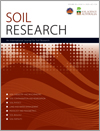Earthworm abundance promoted integral air-water energy (AWr) under dung pats over time, but a hypothesised threshold of extreme earthworm abundance attenuated AWr increase. Earthworm abundance under dung pats appeared to increase AWr under spatially distant (>2 m) control swards. There was no legacy effect of earthworm abundance on macropore density under dung pats and control sward, but did lead to a lower AWr under dung pats after 27 weeks.

Soil Research
Volume 58 Number 5 2020
SR20099Linking phosphorus sorption and magnetic susceptibility in clays and tropical soils
The soil magnetic susceptibility indicates the presence of maghemite and is an important tool for environment discrimination. We investigated the relationship between phosphorus (P) adsorption and magnetic susceptibility in tropical soils, soil clays and synthetic maghemite. This relationship was more evident in red soils formed from basic igneous rocks. The substantial P adsorption of synthetic maghemite confirmed the adsorption for soil clays, which were influenced by magnetic susceptibility, maghemite and gibbsite, and specific surface area.
We collected a database of 26 variables involving belowground carbon (C) and nitrogen (N) cycling covering 209 sites along a climatic gradient in China. Arbuscular mycorrhizal (AM) forests had significantly lower soil total C and N contents, and soil microbial biomass C and N than ectomycorrhizal (ECM) forests. AM forests showed significantly higher litter input, litter decomposition and soil respiration than ECM forests, suggesting that AM forests are more sensitive and ECM forests have greater ability to adapt to global climate change.
Returning corn straw to the soil is a good practice to improve soil organic carbon (C) and humus C composition. This practice enriches the soil with aliphatic, hydroxyl, methoxyl and carboxyl groups and hydrophobic C. Improved methoxyl, hydrophobic and aliphatic C character is very important for long-term stabilisation and regeneration of soil C.
Pyroligneous acid is a complex aqueous liquid fraction produced during the combustion of woody biomass that can provide beneficial or toxic effects on soil and plants, depending on the doses used. The effects of pyroligneous acid on the soil microbial community were investigated, in order to gather further information on its toxicity or stimulation. Our results indicate that pyroligneous acid had no negative effects on the soil, but only if it was distributed at doses up to 1% dilution.
Degradation of soil quality and biota is threatening the long-term sustainability of the conventional rice–wheat cropping system of north-west India. Resource conservation technologies (RCTs) such as zero tillage and keeping the residue at the soil surface showed potential in improving soil health. The adoption of RCTs is a useful option for maintaining or enhancing sustainability of the rice–wheat system, which provides staple food in South Asia.
SR19121Importance of adding woodchips to local amendments for improving soil health and increasing yield in severely degraded soils of Northern China
 , Yingzhong Xie, Rebecca L. Schneider, Stephen J. Morreale, Xiaoyan Bo, Xilu Ni and Changxiao Li
, Yingzhong Xie, Rebecca L. Schneider, Stephen J. Morreale, Xiaoyan Bo, Xilu Ni and Changxiao Li
Solutions are urgently needed to address the continued degradation of agricultural soils worldwide, which has severely impacted the ability to grow crops. This study compared unique, previously untested wood chips with tradition local organic amendments manure and crop straw for improving health of desertified soil. We found that incorporation of wood chips, in combination with traditional local amendments, provides a valuable new approach to restoration of severely degraded soils.
SR19296Soil structure characteristics, functional properties and consistency limits response to corn cob biochar particle size and application rates in a 36-month pot experiment
 , Eric Oppong Danso
, Eric Oppong Danso  , Nastaran Pouladi, Stephen Abenney-Mickson, Edward Benjamin Sabi, Francis Monnie and Emmanuel Arthur
, Nastaran Pouladi, Stephen Abenney-Mickson, Edward Benjamin Sabi, Francis Monnie and Emmanuel Arthur
We investigated impacts of corn cob biochar on properties of a tropical sandy clay loam soil. Biochar of different particle sizes applied at various rates did not significantly modify soil structure characteristics and functions, or consistency limits. Findings suggest that soil and biochar types should be considered when selecting biochar as a soil amendment to improve soil conditions for crop production.
The intensive cultivation of the puddled transplanted rice–wheat cropping system in north-west India has led to the overexploitation of ground water resources. Direct-seeded rice (DSR) is a potent option and deep tillage before the sowing of DSR and the start of the monsoon season can prove important in saving water. The deep tillage done before sowing of DSR proved profitable in terms of increasing water productivity.
The absorption of rain and irrigation water by soils, called the infiltration process, is of vital importance for plant growth. This process is controlled by the permeability properties of soils, and this paper presents new methods for determining these properties and new equations describing the infiltration process more precisely than in previous works. These contributions allow a better understanding of the infiltration process and more precise calculation of water infiltration rates under conditions imposed by both nature and irrigation practices.



